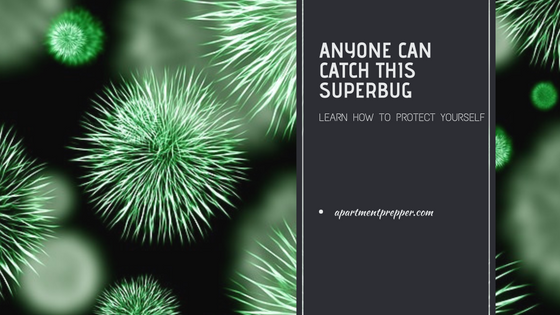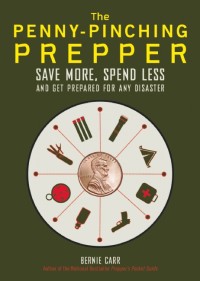This post is by Bernie Carr, apartmentprepper.com
At the office today we heard about a colleague who was admitted to the hospital and won’t be back for a while. She had a small wound that steadily got worse, leading to an infection, fever and now a hospital stay. She had to be treated with IV antibiotics and will need to wear a bag near the wound site to continuously flush the wound with antibiotics for a month. Her husband who helped change her gauze bandage before they knew what she had, had a small shaving cut, and he caught it as well. He was not hospitalized but now has to take strong oral antibiotics. The couple is in their mid-thirties and were in good health until this incident.
What happened to them?
My colleague contracted MRSA, which stands for Methicillin-Resistant Staphylococcus Aureos. MRSA is deemed a “superbug” because it is a type of bacteria that is resistant to most common antibiotics such as Amoxycillin, Penicillin, Oxacillin and Methillin. Her husband, who helped change her dressing, must have touched the infected bandage, touched his own skin and inadvertently caught it himself.
Judging by the reaction at the office, many people are not aware of MRSA. So I thought I’d better do some research to spread the word about this highly contagious and potentially deadly (if left untreated) condition.
I found out there are two kinds:
HA- MRSA: Healthcare Associated MRSA – the kind that is spread in hospitals, long-term care facilities, nursing homes or other care centers. Patients who are affected may have had surgery, or wears a catheter or had some kind of in a healthcare facility. The average age of patients who catch HA-MRSA: 68 years old.
CA-MRSA: Community-Associated MRSA – this affects healthy people who have never even gone to the hospital. The average age of people who contract it: 23 years old.
Of the two types, my understanding is HA-MRSA is more resistant than CA-MRSA but both can turn dangerous nonetheless.
How do you catch It?
Both types share the following “C’s” to remember:
– Crowding
– Cuts
– Contaminated surfaces or skin
– Unclean surroundings
– Contact with skin
Who is at risk of catching it?
Normal, perfectly healthy people can be susceptible to MRSA; after all, anyone can easily get a small cut or insect bite that can get infected. But these groups are particularly vulnerable:
- Diabetics
- Anyone with a compromised or weak immune system
- Young children
- Elderly
- College students in dorms, children in child care centers, or personnel in military installations
- People who go to the beach where waters are known to carry the bacteria such as Florida or West Coast beaches
- Anyone who uses locker rooms or gyms
- Healthcare workers
- Hospital patients or long-term care facilities
As you can see, a wide swath of the population is at risk. Some medical professionals believe the bacteria can be present anywhere, including our own nostrils. Usually, nothing happens, but it becomes dangerous when it enters the bloodstream through a cut.
What are the Symptoms?
See your doctor right away if you experience the following symptoms or if you have a wound that is not showing signs of healing in a day or so:
- The injured area becomes red, swollen and painful. The area may become filled with pus and drainage may occur.
- Other symptoms include a headache, muscle aches, fever, and chest pain.
- Worsening symptoms may include high fever, chills, difficulty breathing, joint pain, low blood pressure, severe headache and extreme fatigue
- The infection can enter the bloodstream and cause blood poisoning, other organs getting infected and pneumonia.
Most of the time oral antibiotics can easily cure the infection. However, if the infection continues or keeps getting worse even after taking the prescribed antibiotics, call your doctor to report your condition.
How to Protect Yourself and Your Family
I don’t want you to become alarmed or paranoid, but just be aware so you can protect yourself and your family with these common-sense steps:
- Wash your hands thoroughly with soap and water. Also, teach children proper hand washing technique. Hand washing should last long enough to be able to sing “Happy Birthday,” or recite the alphabet. If unable to wash your hands, wiping with an alcohol bases sanitizer will suffice.
- Do not share towels or razors. You may not do this yourself, but again, teach your kids, as a lot of teenagers in locker rooms may do so.
- Treat any cuts, burns or insect bites or puncture wounds, even minor ones, with an antiseptic and cover them with a band-aid.
- Avoid touching anyone else’s wounds or use sterile gloves if you are helping dress a wound with gauze or bandage.
- Restrict usage of antibiotics, as widespread antibiotic use causes bacteria to become more resistant.
- Wipe down any surfaces when using machines at the gym.
In a long-term disaster, the spread of bacteria such as MRSA can only get worse with reduced sanitation and possible lack of medical facilities. For your emergency supplies, stock up on band-aids, hydrogen peroxide, Bactine, Hibiclens, sterile gloves for your First Aid kit. Don’t forget to stock up on water for washing, soap, and antibacterial cleaners.
Disclaimer: I am not a healthcare professional; all recommendations are for information purposes only and not to be taken as medical advice. Do your own research or see your doctor for specifics about MRSA if you are concerned.
About the author:
Bernie Carr is the founder of Apartment Prepper. She has written several books including the best-selling Prepper’s Pocket Guide, Jake and Miller’s Big Adventure, The Penny-Pinching Prepper and How to Prepare for Most Emergencies on a $50 a Month Budget. Her work appears in sites such as the Allstate Blog and Clark.com, as well as print magazines such as Backwoods Survival Guide and Prepper Survival Guide. She has been featured in national publications such as Fox Business and Popular Mechanics. Learn more about Bernie here.
For tips on prepping on small budget, read my book:



very good information. I would add using a strong bleach and water solution to use to spray down and clean any equipment in a gym that you are going to use. This solution can also be used to clean and disinfect your hands if needed too. Good reason to add “Pool Shock” to your supplies. This keeps where chlorine bleach in a jug goes bad in a few months.
Hi oldguy, I like the idea of bringing a disinfecting solution to the gym. Their antibacterial hand station is empty a lot of times, so it’s best to have your own. Pool shock is good to have as well. Thanks for the comment.